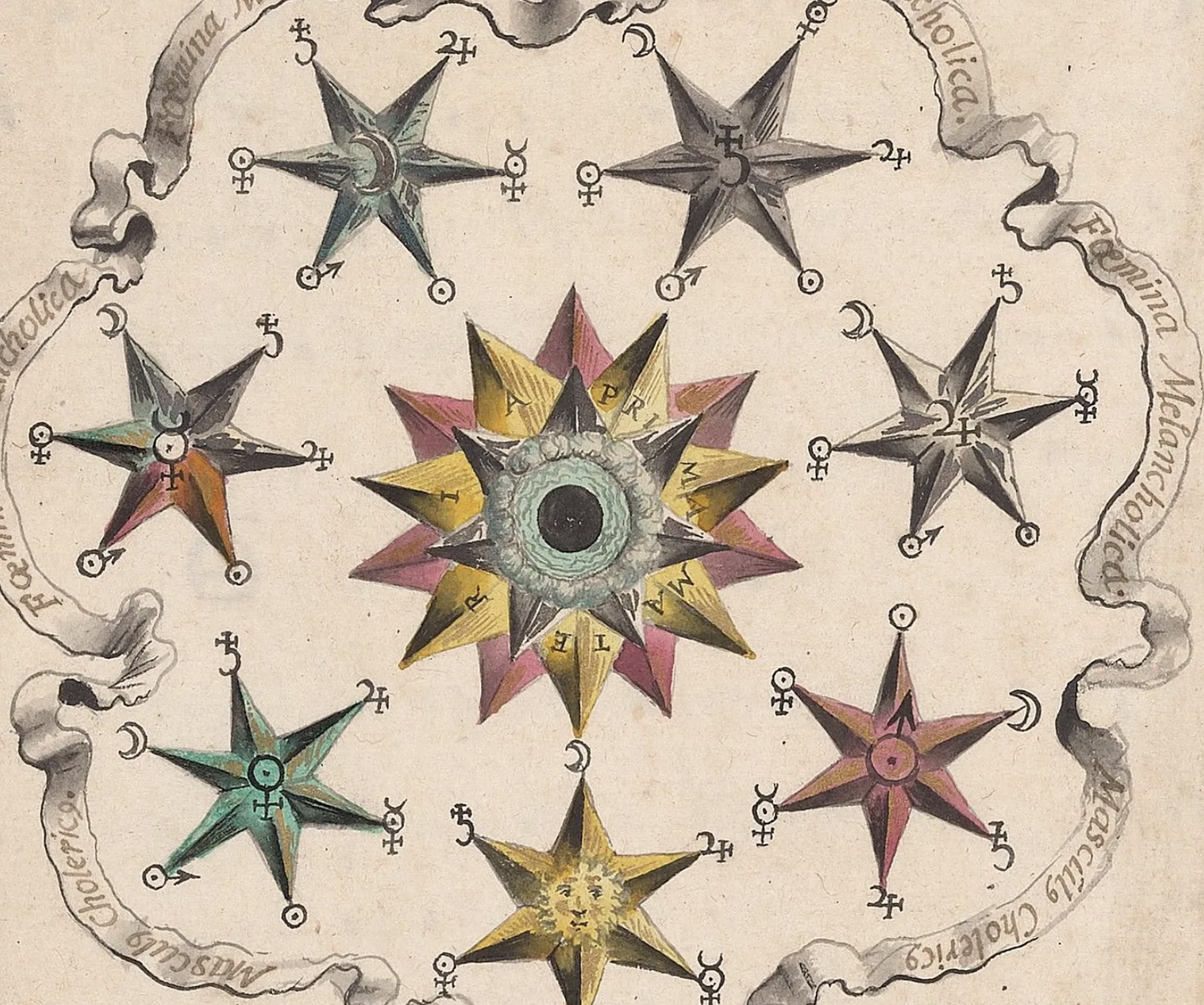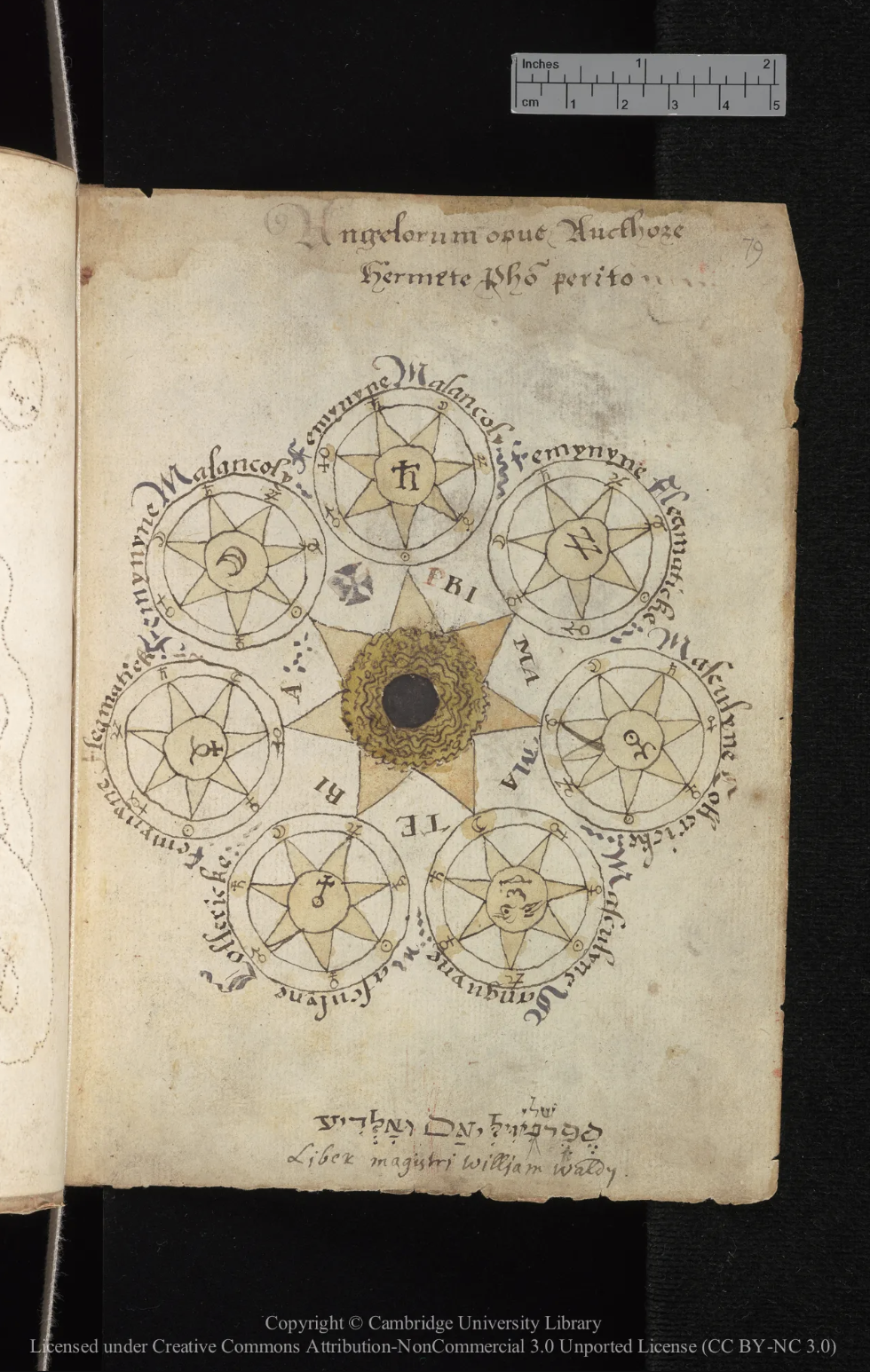Reinventing the Wheel: A 16th Century Alchemical Symbol, Isaac Newton, and the Crux of Modernity
The alchemical cogs of history spun and danced as they drove modernity. It is apt that the image below hearkens to such cogs.
Here we find an incredible Newtonian image, albeit with curious alchemical roots:
Lapis Philosophicus cum suis rotis elementaribus
This diagram is entitled Lapis Philosophicus cum suis rotis elementaribus. The Latin title roughly translates to "The elements of the philosophical stone with its wheels.”
The photo comes from Yale University Beinecke Rare Book & Manuscript Library’s Alchemical and rosicrucian compendium (Mellon MS 28), dated c.a. 1760.
The symbolic wheel shown here — whose originating creator unfortunately remains anonymous — derives from a much simpler Issac Newton notation. That notation, a small drawing, comes from a manuscript also titled Lapis Philosophicus cum suis rotis elementaribus. The work is dated c.a. 1690, and a copy of Newton’s version may be seen below.
Earlier notation of Lapis Philosophicus cum suis rotis elementaribus
This diagram comes via Dr. Mark R. Leach's Chemgnosis website. It was likely derived from the original catalog entry from Sotheby's where the manuscript was dealt.
According to Leach’s Chemgnosis web book:
“In 1936 a collection of Newton's papers, amazingly regarded as of "no scientific value" when offered to Cambridge university some fifty years earlier, was purchased at Sotheby's by the respected economist and Newton scholar John Maynard Keynes. Originally left in a stack by Newton when he left his post as the director of the London mint in 1696, these documents had somehow fortuitously escaped the burning of Newton's personal writings arranged after his death, and were discovered two centuries later. Included was a handwritten manuscript entitled Lapis Philosophicus cum suis rotis elementaribus: "The philosophical stone elements with its wheels”’
The wheel contains many notable alchemical and astrological details. The inter-institutional Newton Project has a catalog which notes that Lapis is an:
“…elaborate alchemico-astrological diagram carefully copied in Newton's hand. In the centre is a seven pointed star labelled 'Prima Materia', surrounded by seven more seven-pointed stars each labelled with a gender and humour ('e.g. 'Femina phlegmatica', 'Masculina cholerica'). Each of these in turn is surrounded by the symbols for the seven 'planets'/metals in different configurations. To the right of the diagram, English notes explaining how it should be coloured.”
Closer detail of Lapis Philosophicus cum suis rotis elementaribus
First, it must be noted that Newton himself did not devise the symbol. Earlier precedents may be found in the annals of 16th century alchemical literature. In particular, the depiction appears in a collection of alchemical images from the Coronatio Naturae series.
In English, the Coronatio Naturae series is called The Crowning of Nature. It was treated extensively in the contemporary sphere by alchemy scholar Adam McLean.
As with many alchemical works, definitive authorship is hazy. The extensive copying and scribing of the manuscript further shrouds the identity original creator. McLean himself notes that the textual portion of the work derives much of its content from the Rosarium Philosophorum (Rosary of the Philosophers) — one of the most important and storied alchemical manuscripts.
The Coronatio series depicts a number of symbols which detail the processes leading up to the creation of the Lapis Philosophorum — the Philosopher’s Stone which is the end goal of the alchemical work.
Accompanying sub-symbols are found within numerous vessels depicted in the Crowning: toads, doves, crows, and serpents. Each symbol occupies a special symbolic function.
Over 40 versions of versions of the Crowning manuscript exist from the 16th century onward. These include Yale University’s Mellon MS 57, University of Glasgow’s numerous MSS. Ferguson editions, University of Cambridge’s MS Gg.1.8, and the British Library’s Ms. Sloane 12.
For reference, the photo below shows a detailed version of the symbol as it appears in Cambridge University’s MS Gg.1.8 version of Coronatio:
Earlier precedent as found in Cambridge University’s MS Gg.1.8 version of Coronatio Naturae.
As with the original image above, each node, or cog, on the wheel contains a central symbol associated to one of the seven classical planets. From the top left of the original image moving clockwise, they are:
Moon, Saturn, Jupiter, Mars, Sun, Venus, Mercury.
In alchemical frameworks, each of these planets contain an associated metal
Moon (Silver)
Saturn (Lead)
Jupiter (Tin)
Mars (Iron)
Sun (Gold)
Venus (Copper)
Mercury (Quicksilver).
For example, the symbol for Saturn (♄) can be seen in the top portion of each respective wheel, just to the right of the Moon. Further, the border of each planetary cog contains each symbol for every other!
The hub of the overall wheel displays an vision of primordial Chaos. Bordering that central point, a banner of lettering spells out Prima Materia. This term translates to First Matter. The Prima materia is the formless and chaotic underlying component from which the alchemical opus commences.
Finally, outside the greater wheel, a number of temperaments (Melancholica, Cholerica, etc.) are coupled with masculine and feminine associations.
In all, the image depicts a the foundational and constituent qualities of the alchemical work.
The Newtonian iteration of the image roots it within an historical context. Newton stood at the crux of alchemy and modern science.
As a harbinger of the modern era, Newton’s usage of a distinctly alchemical diagram situates him at a crossroads — One which allows readers to trace the development of modernity. Indeed, it was during this period that alchemy began to peel off into modern chemistry.
Furthermore, philosophical figures such as Descartes solidified the epistemological bedrock of modernity. In doing so, the extrication of mind from matter began to take shape. As such, Descartes himself served to inadvertently divorce from alchemy the participatory functions that bestowed its mystical potency.
Later, in the 20th century, Carl Gustav Jung would revive a serious look at alchemy. Jung’s work hearkens to the era of consciousness prior to the enactment of these processes. Through a psychoanalytic lens, Jung explored the way in which the alchemists projected the contents of their unconscious psyche on to matter. He then detailed how the alchemists mapped these processes in complex and vivid symbols.
Further, recall the Prima Materia. Note that during the Early Modern period Western philosophy also concerned itself with notions of substance, a term meaning that which stands-under all manifested material. Associations to philosophical conceptions of substance notably come from figures like Baruch Spinoza and John Locke. In both cases, substance resonates with the idea of a formless base which precedes and upholds all qualitative forms: a Prima Materia.
All of these considerations are invoked from the alchemical image shown above.
One may be also struck by the potential for a mapping of the image over rudimentary computing systems. The wheel implies the presence of motion, and a cog-like structure. If one considers how each planetary node contains a surrounding schema of likewise-planetary symbols, a computational schema may be inferred.
So, rumination and considerations of mysticism and modernity abound. Often, as is the case here, one uncovers them nested within the other. In turn, they beckon us not only to explore the mystical core of the modern world, but to see modernity as an entryway into alchemical study.
Bibliography:
• Freeman, Dr. James. Compilation of alchemical works, including the 'Crowning of Nature' (MS Gg.1.8). Cambridge University Digital Library. Cambridge University. n.d.
• Leach, Dr. Mark R. Newton's Lapis Philosophicus cum suis rotis elementaribus in The Chemgnosis Web Book. meta-synthesis. 1999-2003.
• McLean, Adam. The Crowning of Nature - Introduction. The Alchemy Website/Levity. n.d.
• The Newton Project. Catalogue Entry: ALCH00090. Miscellaneous alchemical notes and emblems, in Latin and English with some French. The Newton Project/various authors. 2023
Images:
• Alchemical and rosicrucian compendium/Mellon MS 110. Author unlisted. ca. 1760. Beinecke Rare Book & Manuscript Library. Yale University.
• Freeman, Dr. James. Compilation of alchemical works, including the 'Crowning of Nature' (MS Gg.1.8). 17th century. Cambridge University Digital Library. Cambridge University. Creative Commons Attribution-NonCommercial 3.0 Unported License (CC BY-NC 3.0).
• Leach, Dr. Mark R. Newton's Lapis Philosophicus cum suis rotis elementaribus in The Chemgnosis Web Book. meta-synthesis. 1999-2003.




